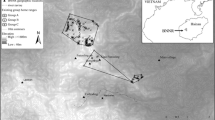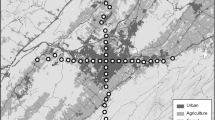Abstract
Successful management practices for declining bird species depend often on long-term surveys acquired by point counts. Despite high standardization of field protocols, uncertain detection probability remains an important source of variability and bias in point-count data. This effect is of main importance in low-responsive species as the Red-legged partridge (Alectoris rufa), but it can be counterbalanced, increasing detection probability. In this 2-year study, we sampled using traditional point-count methods, followed by playback sessions for each repetition. We measured detection probability and the efficiency of playback for detectability in the context of a feasibility study on long-term point-count surveys for a harvested game bird, the Red-legged partridge. The results for both study years show a distinct increase in detection probability (23% and 45%, respectively) when using playback vs. the traditional point-count method. We also tested our results for heterogeneity, trap dependence, and time dependence, and no effect was detected. Thus, we suggest that the future design of long-term surveys on Red-legged partridges should consider abundance indices using playback sessions.


Similar content being viewed by others
References
Aebischer NJ, Potts GR (1994) Red-legged partridge (Alectoris rufa). In: Tucker GM, Heath MF (eds) Birds in Europe: their conservation status. BirdLife, Cambridge, pp 214–215
Alldredge M, Pollock K, Simons T, Collazo J, Shriner S (2007a) Time-of-detection method for estimating abundance from point-count surveys. The Auk 124:653–664
Alldredge MW, Simons TR, Pollock KH (2007b) A field evaluation of distance measurement error in auditory avian point count surveys. J Wildlife Manage 71(8):2759–2766
Allen T, Finkbeiner SL, Johnson DH (2004) Comparison of detection rates of breeding marsh birds in passive and playback surveys at Lacreek National Wildlife Refuge, South Dakota. Waterbirds 27(3):277–281
Anderson DR, Burnham KP (1999) Understanding information criteria for selection among capture–recapture or ring recovery models. Bird Study 46 (Suppl):14–21
Bibby CJN, Burgess ND, Hill DA (1992) Bird census techniques. Academic, San Diego
BirdLife-International (2004) Birds in Europe: population estimates, trends and conservation status. Wageningen, BirdLife conservation Series
Blondel J, Ferry C, Frochot B (1981) Point counts with unlimited distance. Stud Avian biol 6:414–420
Boutin JM, Barbier L, Roux D (2001) Suivi des effectifs nicheurs d’alaudidés, colombidé et turdidés en France: le programme ACT. Alauda 69:53–61
Boutin JM, Roux D, Eraud C (2003) Breeding bird monitoring in France: the ACT Survey. Ornis Hungarica 12–13:1–2
Brewster JP, Simons TR (2009) Testing the importance of auditory detections in avian point counts. J Field Ornithol 80(2):178–182
Carsuzaa S (1996) Validation d'une méthode de recensement des Perdrix rouges au printemps par utilisation de chants préenregistrés. Université de Montpellier II, DESS Dissertation
Ceugniet M, Aubin T (2001) The rally call recognition in males of two hybridizing partridge species, red-legged (Alectoris rufa) and rock (A-graeca) partridges. Behav Process 55(1):1–12
Dawson DK, Smith DR, Robbins CS (1995) Point count length and detection of forest neotropical migrants birds. USDA Forest Service Gen Tech Rep 149:35–43
Dettmers R, Buehler DA, Bartlett JG, Klaus NA (1999) Influence of point count length and repeated visits on habitat model performance. J Wildlife Manage 63(3):815–823
Elphick CS (2008) How you count counts: the importance of methods research in applied ecology. J Appl Ecol 45:1313–1320, Letter to editors EJWR
Eraud C, Boutin J-M, Roux D, Faivre B (2007) Spatial dynamics of an invasive bird species assessed using robust design occupancy analysis: the case of the Eurasian collared dove (Streptopelia decaocto) in France. J Biogeogr 34:1077–1086
Evans SA, Mougeot F, Redpath SM, Leckie F (2007) Alternative methods for estimating density in an upland game bird: the red grouse Lagopus lagopus scoticus. Wildl Biol 13:130–139
Ferry C, Frochot B (1970) L’avifaune nidificatrice d’une forêt de Chêne pédonculés en Bourgogne: étude de deux successions écologiques. Terre Vie 24:153–250
Gonzalo-Turpin H, Sirami C, Brotons L, Gonzalo L, Martin J-L (2008) Teasing out biological effects and sampling artifacts when using occupancy rate in monitoring programs. J Field Ornithol 79(2):159–169
Huggins RM (1991) Some practical aspects of a conditional likelihood approach to capture experiments. Biometrics 47:725–732
Johnson DH (2008) In defense of indices: the case of bird surveys. J Wildlife Manage 72(4):857–868
Julliard R, Jiguet F, Couvet D (2004) Common birds facing global changes: what makes a species at risk? Global Change Biol 10(1):148–154
Kasprzykowski Z, Goławski A (2009) Does the use of playback affect the estimates of numbers of the grey partridge Perdix perdix? Wildl Biol 15(2):123–128
Kubel J-E, Yahner R-H (2007) Detection probability of Golden-winged Warblers during point counts with and without playback recordings. J Field Ornithol 78(2):195–205
Mace GM, Collar NJ, Gaston KJ, Hilton-Taylor C, Akcakaya HR, Leader-Williams N, Milner-Gulland EJ, Stuart SN (2008) Quantification of extinction risk: IUCN's system for classifying threatened species. Conserv Biol 22(6):1424–1442
Marion WR, O'Meara TE, Maehr DS (1981) Use of playbacks in sampling elusive or secretive birds. In: Ralph CJ, Scot JM (eds) Estimating the numbers of terrestrial birds, vol 6. Cooper Ornithological Society, Los Angeles, pp 81–85
Novoa C (1992) Validation of a spring density index for Pyrenean grey partridge, Perdix perdix hispaniensis obtained with playbacks of recorded calls. Gibier Faune Sauvage 9:105–118
Otis DL, Burnham KP, White GC, Anderson DR (1978) Statistical inference from capture data on closed animal populations. Wildlife Monogr 62:135
Pagano AM, Arnold TW (2009) Estimating detection probabilities of waterfowl broods from ground-based surveys. J Wildlife Manage 73(5):686–694
Pépin D, Fouquet M (1992) Factors affecting the incidence of dawn calling in red-legged and grey partridges. Behav Process 26:167–176
Pollock KH (1982) A capture-recapture design robust to unequal probability of capture. J Wildl Manage 46:757–760
Pollock KH, Nichols JD, Simons TR, Farnsworth GR, Bailey LL, Sauer JR (2002) Large scale wildlife monitoring studies: statistical methods for design and analysis. Environmetrics 13:1–15
Ponce-Boutin F, Mathon JF, Puchala JB (2001) Population dynamics of red-legged partridge (Alectoris rufa) In 'IUGB Congress-Perdix IX', 2001, Chypre
Ponce-Boutin F, Tl B, Mathon JF, Moutarde C, Corda E, Kmiec L (2004) Aménagement des milieux et perdrix rouge en collines méditerranéennes françaises. Faune sauvage 262:42–46
Ponce-Boutin F, Brun J-C, Ricci J-C (2006) La perdrix rouge et sa chasse en région méditerranéenne française: résultats d'une enquête. Faune sauvage 274:40–47
Ponce-Boutin F, Mathon J, LeBrun T (2009) Impact of game crops intensification and huntingmanagement on red-legged partridge. In: Cederbaum S, Faircloth B, Terhun T, Thompson J, Carroll J (eds) Gamebird 2006: Quail VI and Perdix XII. 2006. Warnell School of Forestry and Natural Resources, Athens, pp 124–127
Putaala A, Hissa R (1998) Breeding dispersal and demography of wild and hand-reared grey partridges Perdix perdix in Finland. Wildl Biol 4:137–145
Ralph CJ, Sauer JR, Droege S (1995) Monitoring bird populations by point counts. General Technical Report. PSW-GTR-149. In: Agriculture USDo (ed) Pacific Southwest Research Station. Canada, Forest Service, Albany
Reitz F (2003) Le statut communal de la perdrix grise et de la perdrix rouge en France: résultats d'une enquète. Faune sauvage 258:25–33
Rosenstock SS, Anderson DR, Giesen KM, Leukering T, Carter MF (2002) Landbird counting techniques: current practices and an alternative. Auk 119:46–53
Schoppers J (1996) Cassetterecorder goed hulpmiddel bij inventarisatie Patrijs Perdix perdix in het broedseizoen: tape recorder useful in breeding season surveys of Partridge Perdix perdix. Limosa 69:180–181
Seoane J, Carrascal LM (2007) Interspecific differences in population trends of Spanish birds are related to habitat and climatic preferences. Global Ecol Biogeogr 1:11
Verner J (1985) Assessment of counting techniques. Curr Ornithol 2:247–302
White GC, Burnham KP (1999) Program MARK: survival rate estimation from both live and dead encounters. Bird study (Suppl) 46:120–139
Zimmerling JR, Ankney CD (2000) A technique that increases detectability of passerine species during point counts. J Field Ornithol 71:638–649
Acknowledgments
This study was financed by ONCFS through conventions with FRC-LR and FDC 34. We are grateful to the members of ONCFS and FRC-LR staff, who participated to the field surveys, Laura Dami, Jean-Christian Favas, Jean-Bernard Puchala (ONCFS CNERA PFSP), as well as L. Tatin (Domaines de Listel). In 2009, some regional hunting societies tested our protocol, we are grateful to them. We thank the land owners for allowing the access during our field season.
Author information
Authors and Affiliations
Corresponding author
Additional information
Communicated by C. Gortázar
Rights and permissions
About this article
Cite this article
Jakob, C., Ponce-Boutin, F., Besnard, A. et al. On the efficiency of using song playback during call count surveys of Red-legged partridges (Alectoris rufa). Eur J Wildl Res 56, 907–913 (2010). https://doi.org/10.1007/s10344-010-0388-7
Received:
Revised:
Accepted:
Published:
Issue Date:
DOI: https://doi.org/10.1007/s10344-010-0388-7




